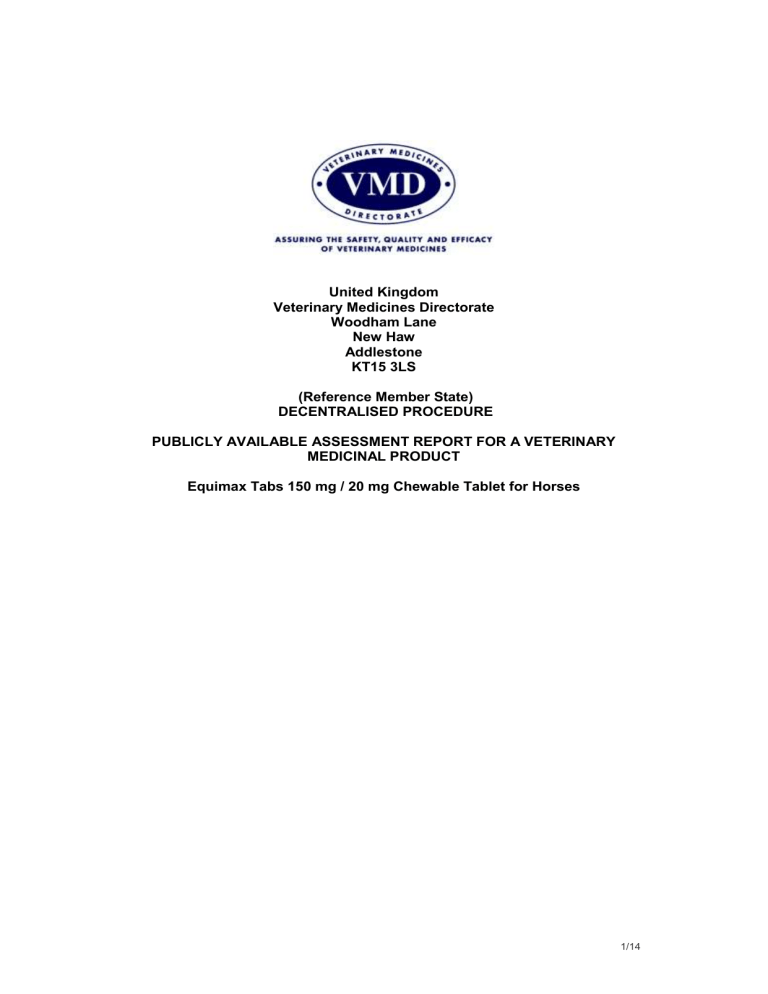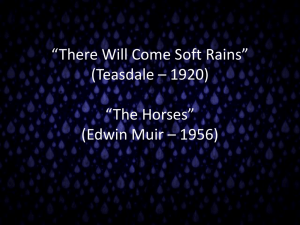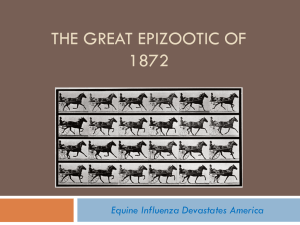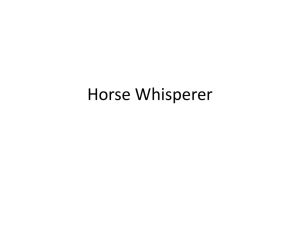United Kingdom Veterinary Medicines Directorate Woodham Lane

United Kingdom
Veterinary Medicines Directorate
Woodham Lane
New Haw
Addlestone
KT15 3LS
(Reference Member State)
DECENTRALISED PROCEDURE
PUBLICLY AVAILABLE ASSESSMENT REPORT FOR A VETERINARY
MEDICINAL PRODUCT
Equimax Tabs 150 mg / 20 mg Chewable Tablet for Horses
1/14
Equimax Tabs 150 mg / 20 mg Chewable Tablet for Horses
Virbac S.A.
UK/V/0258/001/DC
Application for Decentralised Procedure
Publicly Available Assessment Report
MODULE 1
PRODUCT SUMMARY
EU Procedure number
Name, strength and pharmaceutical form
Applicant
Active substances
ATC Vetcode
Target species
Indication for use
UK/V/0258/001/DC
Equimax Tabs 150 mg / 20 mg Chewable
Tablet for Horses
Virbac S.A.
Ivermectin
Praziquantel
QP54AA51
Horses
For the treatment of mixed cestode, nematode and arthropod infestations, due to adult and immature roundworms, lungworms, bots and tapeworms in horses:
• Nematodes
Large-strongyles:
Strongylus vulgaris (adult and arterial larvae)
Strongylus edentatus (adult and L4 tissue larval stages)
Strongylus equinus (adult and L4 larval stage)
Triodontophorus spp . (adult)
Small-strongyles:
Cyathostomum (adult and non-encysted mucosal larvae): Cylicocyclus spp.,
Cylicostephanus spp., Gyalocephalus spp.
Parascaris: Parascaris equorum (adult and larvae).
Oxyuris: Oxyuris equi (adult and larvae).
Trichostrongylus: Trichostrongylus axei (adult).
• Cestodes ( Tapeworm): Anoplocephala perfoliata Anoplocephala magna,
Paranoplocephala mamillana
• Dipteran insects: Gasterophilus spp.
(larvae).
As tapeworm infestation is unlikely to occur in horses before two months of age, treatment of foals below this age is not considered necessary.
2/14
Equimax Tabs 150 mg / 20 mg Chewable Tablet for Horses
Virbac S.A.
UK/V/0258/001/DC
Application for Decentralised Procedure
Publicly Available Assessment Report
MODULE 2
The Summary of Product Characteristics (SPC) for this product is available on the Heads of Medicines Agencies (veterinary) (HMA(v)) website ( www.hma.eu
).
3/14
Equimax Tabs 150 mg / 20 mg Chewable Tablet for Horses
Virbac S.A.
UK/V/0258/001/DC
Application for Decentralised Procedure
Publicly Available Assessment Report
MODULE 3
PUBLIC ASSESSMENT REPORT
Legal basis of original application
Decentralised application in accordance with
Article 12 of Directive 2001/82/EC as amended.
Date of completion of the original decentralised procedure
Date product first authorised in the Reference Member
State (MRP only)
Concerned Member States for original procedure
28 May 2008
N/A
Austria
Belgium
Bulgaria
Cyprus
Czech Republic
Denmark
Estonia
Finland
France
Germany
Greece
Hungary
Iceland
Ireland
Italy
Latvia
Lithuania
Luxembourg
Malta
The Netherlands
Norway
Poland
Portugal
Romania
Slovak Republic
Slovenia
Spain
Sweden
4/14
Equimax Tabs 150 mg / 20 mg Chewable Tablet for Horses
Virbac S.A.
UK/V/0258/001/DC
Application for Decentralised Procedure
Publicly Available Assessment Report
I. SCIENTIFIC OVERVIEW
The product is produced and controlled using validated methods and tests which ensure the consistency of the product released on the market. It has been shown that the product can be safely used in the target species; the slight reactions observed are indicated in the SPC. The product is safe for the user, the consumer of foodstuffs from treated animals and for the environment, when used as recommended. Suitable warnings and precautions are indicated in the
SPC. The efficacy of the product was demonstrated according to the claims made in the SPC. The overall risk/benefit analysis is in favour of granting a marketing authorisation.
II. QUALITY ASPECTS
A. Composition
The product contains the active substances ivermectin and praziquantel.
Excipients are as follows: povidone, crospovidone, cellulose, microcrystalline, cider applemarc (pressed apple pulp), glucose liquid, starch pregelatinised, compressible sugar and magnesium stearate.
The container/closure system comprises a carton box containing 1, 2, 12, 40 or
48 polypropylene tubes of 8 tablets closed by a child proof cap. The particulars of the containers and controls performed are provided and conform to the regulation.
The choice of the formulation and absence of preservative are justified. The product is an established pharmaceutical form and its development is adequately described in accordance with the relevant European guidelines.
B. Method of Preparation of the Product
The product is manufactured fully in accordance with the principles of good manufacturing practice from a licensed manufacturing site .
Process validation data on the product have been presented in accordance with the relevant European guidelines.
C. Control of Starting Materials
One of the active substances is ivermectin, an established active substance described in the European Pharmacopoeia. The active substance is manufactured in accordance with the principles of good manufacturing practice.
The active substance specification is considered adequate to control the quality of the material. Batch analytical data demonstrating compliance with this specification have been provided.
The second active substance is praziquantel and data have been provided in the form of a European Drug Master File (EDMF). It is considered that the manufacturing process is adequately controlled and the active substance specification has been suitably justified.
5/14
Equimax Tabs 150 mg / 20 mg Chewable Tablet for Horses
Virbac S.A.
UK/V/0258/001/DC
Application for Decentralised Procedure
Publicly Available Assessment Report
All the excipients, with the exception of apple marc, are the subject of monographs in the European Pharmacopoeia and are provided to that standard.
Apple marc complies with manufacturers specifications.
D. Specific Measures concerning the Prevention of the Transmission of Animal Spongiform Encephalopathies
There are no substances within the scope of the TSE Guideline present or used in the manufacture of this product .
E. Control on intermediate products
There are no intermediate products.
F. Control Tests on the Finished Product
The finished product specification controls the relevant parameters for the pharmaceutical form. The tests in the specification, and their limits, have been justified and are considered appropriate to adequately control the quality of the product.
Satisfactory validation data for the analytical methods have been provided.
Batch analytical data from the proposed production site have been provided demonstrating compliance with the specification.
G. Stability
No stability data are presented for ivermectin, although certificates of suitability for the raw material were provided. The certificates stated that a three year retest interval was appropriate when stored in a double lined polyethylene heat sealed bag and placed in an aluminium tin. This was considered acceptable.
Stability data on the finished product have been provided in accordance with applicable European guidelines, demonstrating the stability of the product throughout its shelf life when stored under the approved conditions. A shelf life of 18 months was justified, when stored below 30 ºC. Following withdrawal of the first dose, the product should be used within 12 months.
The variation to extend the shelf life of the finished product from 18 months to 30 months with no special precautions for storage was approved in August 2009.
H. Genetically Modified Organisms
Not applicable.
J. Other Information
Shelf life
Shelf life of the veterinary medicinal product as packaged for sale: 30 months
Shelf life after first opening the immediate packaging: 12 months
Special precautions for storage
This veterinary medicinal product does not require any special storage conditions.
6/14
Equimax Tabs 150 mg / 20 mg Chewable Tablet for Horses
Virbac S.A.
UK/V/0258/001/DC
Application for Decentralised Procedure
Publicly Available Assessment Report
III. SAFETY AND RESIDUES ASSESSMENT (PHARMACO-
TOXICOLOGICAL)
III.A Safety Testing
Pharmacological Studies
The applicant has provided data in support of the pharmacodynamics and the pharmacokinetics of both ivermectin and praziquantel. These data demonstrate that both active ingredients of the formulation possess different pharmacodynamic activities. The applicant has also addressed the pharmacokinetics of both actives in combination. It was shown that there is no interference/interaction between ivermectin and praziquantel that could result in changes to the bioavailability or elimination of either active component of the formulation.
Toxicological Studies
Single Dose Toxicity
The applicant has provided published data in support of the acute toxicity of ivermectin and praziquantel. The applicant has additionally provided the reports of two studies investigating the acute oral and dermal toxicity of Equimax in the rat. The results of the two studies on Equimax confirm the literature-derived acute toxicity values of the individual active ingredients. It is clear that ivermectin is the ingredient most responsible for the acute toxicity of the final product. The toxicity profile of ivermectin indicates that the oral LD
50
is in the order of 50 mg/kg in most laboratory species and >400 mg/kg via the dermal route. The total ivermectin content of Equimax is approximately 112 g.
Repeat Dose Toxicity
The applicant provided literature in support of the repeat dose toxicity of the two active ingredients. As with the acute toxicity, ivermectin is the active most responsible for signs of toxicity. This supports the pharmacokinetic data provided that demonstrate the rapid elimination of praziquantel. The applicant has not provided the results of any studies investigating the repeat dose toxicity of the combination and this omission has been fully justified.
In repeat dosing studies, effects were observed with low doses of ivermectin.
No NOEL 1 could be derived in a dog study with the lowest dose of 0.5 mg/kg for
3 months, a NOEL of 0.4 mg/kg was derived in rats treated orally for 3 months and in monkeys the NOEL was >1.2 mg/kg for 14 days.
Reproductive Toxicity, including Teratogenicity:
In reproductive studies in rats, doses as low as 1 mg/kg elicited abnormal behavioural effects in treated animals. An oral dose of 3.6 mg/kg caused effects in two generations. Only one study was reported for embryotoxicity/foetotoxicity, where a NOEL of 1.5 mg/kg was derived in rabbits dosed during the period of organogenesis.
1 NOEL = No observed effect level
7/14
Equimax Tabs 150 mg / 20 mg Chewable Tablet for Horses
Virbac S.A.
UK/V/0258/001/DC
Application for Decentralised Procedure
Publicly Available Assessment Report
Mutagenicity
A number of mutagenicity studies were reported and ivermectin was not mutagenic in these studies.
The toxicity profile of praziquantel was based on published literature.
Praziquantal wais demonstrated to be non-mutagenic.
Carcinogenicity
The applicant provided references to carcinogenicity studies in rats and mice with the related compound abamectin, as no references could be located for carcinogenicity studies with ivermectin. Under the conditions of these studies, abamectin was considered not to be carcinogenic. Reference to these studies in abamectin was acceptable owing to the similarity between abermectin and ivermectin.
Other Studies
Special studies
Praziquantel:
Reference was made to a study in which Schistosoma mansoni infected mice were treated with praziquantel at different stages of the disease in order to determine the effects on liver pathology. It was concluded that earlier treatment reduced or prevented hepatic disease.
The effect of praziquantel on the activities of certain drug metabolising hepatic enzymes in rabbits was investigated. Doses of 40 and 800 mg/kg praziquantel did not affect the enzymes, whereas, doses of 1600 and 2000 mg/kg resulted in a significant decrease in the activities of drug metabolising enzymes. All animals receiving 2000 mg/kg died within 20 hours of dosing.
Ivermectin:
Reference was made to an inhalation study in rats exposed to the maximum attainable concentration of 5.11 mg/l for 60 minutes. Mucosal irritation was the only toxic effect observed during the study.
Ivermectin was shown to produce only slight irritation when 100 mg of powder was applied to the rabbit eye. Ivermectin induced only slight irritation following instillation of 100 mg into the conjunctival sac of the rabbit eye.
A number of other references to studies were also provided.
Observations in Humans
The applicant had provided bibliographic data showing the history of both praziquantel and ivermectin use in humans.
Microbiological Studies
Praziquantel:
Praziquantel does not possess any antifungal or antibacterial activity.
8/14
Equimax Tabs 150 mg / 20 mg Chewable Tablet for Horses
Virbac S.A.
UK/V/0258/001/DC
Application for Decentralised Procedure
Publicly Available Assessment Report
Ivermectin:
Ivermectin is a potent agent against nematodes and arthropods but it has no antifungal, antibacterial or antiprotozoal activity.
Studies on Metabolites, Impurities, Other Substances and Formulation.
Equimax formulation:
The applicant has provided the results of the following studies on the proposed formulation:
Eye irritation study:
The ocular irritancy potential of the combination product in rabbits.was studied.
The test compound was classified as weakly irritant to the rabbit eye.
Skin irritation study:
Details of a rabbit skin test were provided. Under the conditions of this test, the combination product was classified as non-irritant to skin.
Skin sensitisation study:
Details of a skin sensitisation test in guinea pigs were provided. Under the conditions of this test, the combination product did not induce delayed contact hypersensitivity.
User Safety
The applicant has provided a user safety assessment in compliance with the relevant guideline identifying all potential routes of exposure of the user to the product and relating these routes to the toxicity profiles of the individual actives.
The applicant provided a limited toxicity profile of the formulated product but addressed the potential routes of exposure to skin and eyes and the potential to induce delayed contact hypersensitivity.
Warnings and precautions as listed on the product literature are adequate to ensure safety to users of the product.
Ecotoxicity
For horses housed during and after treatment the PECsoil 2 value demonstrated that exposure of the environment was not extensive hence the assessment of this treatment scenario ended at Phase I. The Phase I assessment also concluded that for horses on pasture during and after treatment a Phase II assessment was required as the product was a parasiticide. The Phase II assessment was carried out separately for ivermectin and praziquantel. In addition an assessment of the two actives combined was presented. In the
Phase II assessment only the use of the product in horses at pasture were evaluated. For both ivermectin and praziquantel the following factors were considered: physico-chemical properties and environmental fate, effects on terrestrial and aquatic organisms, metabolism in the target species and a risk assessment of micro-organisms, earthworms (in soil and dung) and dung insects.
2 Predicted environmental concentration (soil)
9/14
Equimax Tabs 150 mg / 20 mg Chewable Tablet for Horses
Virbac S.A.
UK/V/0258/001/DC
Application for Decentralised Procedure
Publicly Available Assessment Report
A Phase II assessment of the two actives in combination for horses on pasture during and after treatment was also presented. It was considered unlikely that any synergistic effect would occur.
The routes of excretion of each compound were compared. Ivermectin is excreted almost exclusively in faeces while praziquantel is excreted equally in urine and in faeces. This pattern of excretion suggested that dung was the major compartment at risk from any synergy between the compounds. Effects data indicate that ivermectin is more toxic to dung fauna than is praziquantel. It was concluded that the ecotoxicity of the combination is mainly dependent on the toxicity of ivermectin.
Warnings and precautions as listed on the product literature are adequate to ensure safety to the environment when the product is used as directed.
III.B Residues documentation
Residue Studies
No residue depletion studies relating to praziquantel were necessary because the withdrawal period for the product is determined by the depletion of residues of ivermectin due to the rapid metabolism and elimination of praziquantel in horses .
The applicant has submitted reports of bioequivalence studies, comparing the product with another product containing ivermectin as the single active. The results demonstrate bioequivalence between the two products, indicating no interactions of ivermectin and praziquantel likely to adversely affect residue depletion.
The applicant also provided a confirmatory residue depletion study which examined residue levels in liver and fat in horses treated with ivermectin/praziquantel paste administered at the maximum recommended therapeutic dose rate. Samples of liver and peri-renal fat were removed for analysis of ivermectin residues. The levels of the marker residue H
2
B
1a
were below the MRL values in both 28 and 35 days after treatment.
MRLs
Ivermectin is listed in Annex I of Council Regulation 2377/90. The marker substance is 22,23-dihydroavermectin B1a.
MRLs are listed below:
Muscle
Liver
Kidney
Fat
Equidae 3
15 µg/kg
15 µg/kg
15 µg/kg
20 µg/kg
3 Equidae is the family of horse-like animals
10/14
Equimax Tabs 150 mg / 20 mg Chewable Tablet for Horses
Virbac S.A.
UK/V/0258/001/DC
Application for Decentralised Procedure
Publicly Available Assessment Report
Praziquantel is listed in Annex II of Council Regulation 2377/90 so no MRLs for this have been assigned.
Withdrawal Periods
Based on the data provided above, a withdrawal period of 35 days for meat in horses has been justified.
IV CLINICAL ASSESSMENT (EFFICACY)
IV.A Pre-Clinical Studies
Pharmacology
The applicant provided information on the modes of action of the two active ingredients. Both of the modes of action of the two compounds are very different and hence it would be unlikely that there would be any interference between them which could adversely affect efficacy or safety.
Ivermectin has a broad antiparasitic activity against nematodes and arthropods and acts by inhibiting nerve impulsess. Ivermectin binds selectively and with high affinity to glutamate-gated chloride ion channels which occur in invertebrate nerve and muscle cells and results in paralysis and death of the relevant parasites. The margin of safety for compounds of this class is attributable to the fact that mammals do not have glutamate-gated chloride channels.
Praziquantel exerts its anthelmintic activity against many species of cestodes and trematodes. It primarily acts by impairing both motility and function of the suckers of cestodes. Its mode of action includes the impairing of neuromuscular co-ordination but also influencing the permeability of the integument of the worms, which leads to excessive calcium and glucose loss. This induces spastic paralysis of the parasite musculature.With regards to pharmacokinetics of the active ingredients / active ingredient combination the applicant provided a combination of published literature and studies.
In the case of praziquantel references were presented on the pharmacokinetics in rats, dogs, rabbits sheep, monkeys and man. Following oral administration the drug was quantitatively and rapidly absorbed and metabolised in these species and was highly bound to plasma protein. Praziquantel was rapidly distributed in body tissues as it is highly lipid soluble. Praziquantel was rapidly eliminated from plasma after oral administration due to a marked first pass effect and only a small amount of unchanged drug reached the general circulation.
Maximum serum concentrations of radioactivity were reached within 30 minutes to 1 hour. No unmetabolised drug was found in any excretion products. The half-life is only a few hours and elimination takes place mainly via the kidneys within the first 24 hours after administration. No specific data on the pharmacokinetic behaviour of praziquantel were available for the horse, but it would seem reasonable to assume that this would also be the case in the horse.
For ivermectin the published literature also included reference to horses.
Ivermectin is a highly lipophilic substance that is extensively distributed.
11/14
Equimax Tabs 150 mg / 20 mg Chewable Tablet for Horses
Virbac S.A.
UK/V/0258/001/DC
Application for Decentralised Procedure
Publicly Available Assessment Report
Following oral administration of ivermectin oral paste at 0.2 mg/kg, ivermectin was detected in plasma between 30 minutes and 30 days post-treatment.
Ivermectin showed a slow clearance and is poorly metabolised. Metabolites are produced in the liver and fat and, although there are some species differences, residues are always highest in these tissues. The main route of excretion is via bile through the faeces.
As well as published literature the applicant also conducted a number of pharmacokinetic studies, two of which involved the combination formulation oral gel containing ivermectin and praziquantel, and one bioavailability study using the final tablet formulation.
Tolerance in the Target Species of Animals
A number of tolerance studies were conducted in young horses, stallions and pregnant and lactating mares given up to five times the recommended dose rate of the gel formulation. A tolerance study was conducted in horses with the tablets administered at up to five times the proposed dose rate. The studies indicated a wide margin of safety for the product. Pre-clinical and clinical studies also indicated good tolerance. It was noted that some indirect adverse effects can occur with ivermectin due to the death of a large number of parasites, but a suitable warning reflects this on the SPC and product literature.
Resistance
The applicant submitted a number of references relating to resistance amongst the common helminths of horses to either ivermectin or praziquante. There was no evidence of resistance to either active ingredient amongst common parasites in horses.
IV.B Clinical Studies
Laboratory Trials
The applicant provided both published literature and studies. Dose titration data taken from the published literature confirmed that the effective oral dose of ivermectin in the horse is 200
g/kg. In the case of praziquantel, the limited published data were supplemented by studies sponsored by the applicant.
These confirmed that the optimal dose rate is 1.5 mg/kg. These studies also provided an indication that the inclusion of ivermectin in the formulation had no effect on efficacy against tapeworms. Further information provided by dose confirmation studies indicated that combining ivermectin with praziquantel had no detrimental effect on efficacy. They also indicated that the inclusion of ivermectin in the formulation had no influence on efficacy. An efficacy greater than 95 % was demonstrated against the majority of nematodes including
P.equorum
(considered to be the dose limiting parasite) in the recently conducted dose confirmation studies using the tablet formulation.
The applicant provided a study that demonstrated efficacy of praziquantel against all 3 species of tapeworm. A.magna
and P.mamillana
are less commonly found compared to A.perfoliata
, however a suitable number of control horses were infested with at least one species.
12/14
Equimax Tabs 150 mg / 20 mg Chewable Tablet for Horses
Virbac S.A.
UK/V/0258/001/DC
Application for Decentralised Procedure
Publicly Available Assessment Report
Several of the studies conducted indicated that there is no interference between the two active substances.
Field Trials
A multicentric field trial using gel formulation was submitted. The trial was conducted in two parts; the first to assess the prevalence of double infection
(with tapeworms and nematodes) in horses, and the second to compare the efficacy of oral gel (praziquantel at 1.5 mg/kg and ivermectin at 0.2 mg/kg) with that of a paste containing 87 % w/w ivermectin, in the treatment of horses and ponies naturally infected with tapeworms ( Anoplocephala spp.) and nematodes
(small and large strongyles). This also allowed assessment of the noninterference of the two active ingredients and the safety of the product.
The prevalence study showed that a total of 72 % of horses had parasitic infections despite a quite short interval since the last worming. 22 % of this population was infected with both nematodes and cestodes based on detection of eggs in the faeces. Of those horses with cestode infestations, 62 % were also infected with nematodes. In view of the low sensitivity of the methods available for detecting tapeworm eggs, the true incidence of cestode infestation in these horses may have been closer to 50 %. Efficacy of both the test product and the paste against nematodes was high and ranged from 96.1-100 % for the gel product and 94.1-100 % for the paste. It was clear from this that the addition of praziquantel to the test product had no detrimental effects on the efficacy of the ivermectin component. Similarly, efficacy against nematodes was the same whether or not cestode infestation was also present. In the case of cestode infestations, efficacy ranged from 97.9-100 % for the test article and again appeared unaffected by concomitant infestations or the presence of ivermectin in the product. This clinical trial confirmed that the oral paste formulation was safe and effective in horses in the treatment of infestations with nematodes and cestodes.
The applicant did not conduct a field trial with the tablet formulation. One dose determination study and two dose confirmation studies were conducted with the tablet formulation. The tablet formulation was shown to be safe and highly effective against all the common nematode parasites of horses as well as tapeworms and bots.
V OVERALL CONCLUSION AND BENEFIT – RISK ASSESSMENT
The data submitted in the dossier demonstrate that when the product is used in accordance with the Summary of Product Characteristics, the risk benefit profile for the target species is favourable and the quality and safety of the product for humans and the environment is acceptable.
13/14
Equimax Tabs 150 mg / 20 mg Chewable Tablet for Horses
Virbac S.A.
UK/V/0258/001/DC
Application for Decentralised Procedure
Publicly Available Assessment Report
MODULE 4
POST-AUTHORISATION ASSESSMENTS
The SPC and package leaflet may be updated to include new information on the quality, safety and efficacy of the veterinary medicinal product. The current SPC is available on the Product Information Database of the Veterinary Medicines
Directorate website.
(www.gov.uk/check-animal-medicine-licensed)
The post-authorisation assessment (PAA) contains information on significant changes which have been made after the original procedure which are important for the quality, safety or efficacy of the product.
The PAA for this product is available on the Product Information Database of the
Veterinary Medicines Directorate website.
(www.gov.uk/check-animal-medicine-licensed)
14/14






